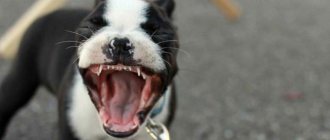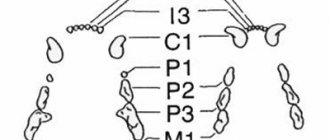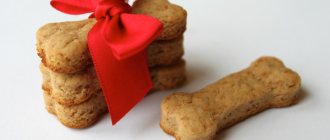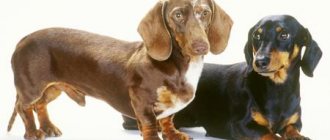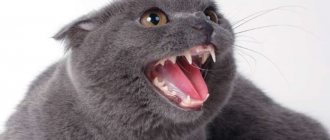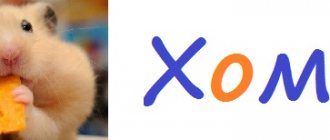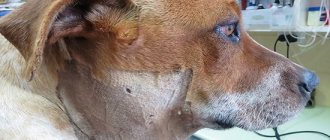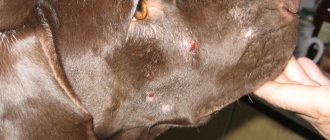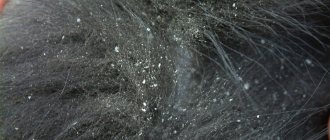The structure of the dog’s oral cavity plays a big role. The general condition of the animal and its life as a whole often depend on how it is developed. However, dog owners often do not know about this and have no idea how many teeth a dog has, and that they must certainly monitor the health of their pet’s mouth and carry out certain hygiene procedures.
We have developed this detailed article together with professional dog handlers and breeders for you so that you can properly care for your beloved pet. Therefore, it is worth reading for everyone who has a dog at home. And it doesn’t matter at all what breed.
Dog dental formula
The dog's permanent teeth have designations made up of numbers and various letters of the Latin alphabet.
The dog’s dental formula in the diagram looks like this:
- 2M 4P 1C 3I 3I 1C 4P 2M.
- 3M 4P 1C 3I 3I 1C 4P 3M.
Letters of the Latin alphabet - names of the type of clove:
- I – incisors.
- M – molars.
- C – fangs.
- P – premolars.
A dental formula is a diagram where a certain number can indicate the number of components, and a letter can indicate their type. The diagram is recorded in the order in which the dog's teeth are in the mouth. This method of recording dental patterns has been used for many years and during this time it has shown its effectiveness.
Possible complications
Dwarf breeds have the hardest time with the change of baby teeth. If your pet is at risk, examine its oral cavity every day so as not to miss warning signs of complications.
Gum inflammation
Accompanied by redness and swelling of the mucous membranes, as well as profuse salivation, which worsens the appearance of the fur on the chest. This complication usually goes away on its own, but sometimes develops into periodontal disease. It can be identified by severe bleeding of the gums and a strong odor from the mouth.
Stuck teeth
Some animals retain 2 rows of teeth at once. This complication is called persistence. It is fraught with increased trauma to the mucous membranes and cheeks, as well as malocclusion.
Be sure to check if your dog has baby teeth next to his molars. If you find two shoots in one hole, contact your veterinarian. Sometimes the problem can be solved by manual loosening, but in most cases surgery cannot be avoided.
Malocclusion
Improper closing of the jaws is typical for breeds with an elongated muzzle: dachshunds, labradors, dobermans, rottweilers. It is facilitated by games of tug of war, feeding exclusively soft food and persistence.
To correct the bite, rubber corrector rings are used that act as braces. If the animal is not a show animal, then it is enough to prevent the situation from worsening and control the position of the jaws.
Malfunctions of the gastrointestinal tract
Quite often, babies experience diarrhea. It is not dangerous, as the stool quickly returns to normal. You should only worry if you experience symptoms of dehydration:
- dry mucous membranes, nose and coat;
- loss of activity and increasing lethargy;
- slow smoothing of skin crumpled into a fold by fingers.
Additionally, vomiting and fever may occur. A pet with such symptoms must be shown to a veterinarian within the first day after their discovery. Otherwise, he may die.
How many teeth does a dog have?
Structure
An adult dog has exactly 42 teeth in its mouth. However, sometimes there is a shortage or excess of chewing devices. The animal's carnivorous denticles are always normal. All predators known to us have them. These are quite strong devices that can easily grind any bones. They grow in dogs in the first year, gradually changing from acute milky ones to full-fledged permanent ones.
How many teeth does an adult dog have?
A dog that is over seven months old should not have temporary teeth in its mouth. A large dog has forty-two teeth: twenty on the upper jaw and another 22 on the lower jaw. You can even find out its exact age by looking at an animal's chewing devices. To accurately determine age, it is important to take into account the level of sharpening of the incisors:
- The front ones wear down a little at the bottom after a year and a half.
- Lower middle from below to - 2.5 years.
- Front on top - by 3.5 years.
- Average on top - by about 4.5 years.
- The last ones from the bottom - by 5.5 years.
- The last ones on top - by the age of six.
Puppy's milk teeth
Dogs are born into this world without teeth. At the beginning of the third week, their temporary teeth begin to erupt:
- Incisors grow at 4-5 weeks.
- The canines continue to grow for 3-5 weeks.
- Premolars in dogs grow in about 5-6 weeks.
Animals that are already two months old should have exactly 28 teeth in their mouth - fourteen on each jaw. When an animal is teething, it is important to understand how you can help her. It is necessary to buy toys that your pet can scratch its gums on. This way he won’t be able to spoil various things.
If the number of teeth is not normal
Not all animals, unfortunately, have the correct dental formula. Today, it is increasingly possible to encounter various deviations in the number of chewing devices, downwards or upwards. The exception is certain breed standards that arose directly during selection. Professionals specially raised them with such a dental apparatus and the number of chewing devices for specific purposes.
Reasons for possible abnormalities in dogs:
- Genetic inheritance.
- Personal characteristics of development and growth.
- Wrong diet.
- Deficiency of vitamin D, calcium and other elements.
- Injuries, illnesses and various metabolic disorders.
Briefly about the main thing
- You need to take care of your dog's teeth from puppyhood.
- During the change of teeth, the puppy needs to be looked after especially carefully.
- An adult large breed dog should have 42 teeth. Shortage or excess is considered a deviation. Representatives of small and medium breeds are allowed a smaller number of teeth, which is not considered a defect.
- An adult dog's teeth should be looked after regularly by purchasing special bones to remove plaque from the teeth. Also, a number of breeds need to clean their jaws with special toothpastes created for dogs.
If you have questions or have an opinion on this topic, leave a comment after reading the article.
Types of teeth
Dogs have three types of teeth, each with a specific function.
Fangs
Fangs are fairly long teeth. They are located directly between the incisors and premolar teeth. There are four of them, two on top and bottom, one on the right and on the left.
Permanent teeth
After the canines come the premolars. There are four of them on all sides. They are found on all jaws. Behind them the molars continue. There are molars on all sides.
Incisors
There should be six of these chewing devices on all the dog’s jaws. To the right and left of the special vertical straight line, which divides the pet’s entire jaw into two halves, there are hooks. Next come the middle ones, and then the edges.
Teeth-safe games and toys
Dog toys should not include: bones (both cooked and raw), cow hooves, pig ears, products made of hard and thick rawhide, plastic or nylon bones; large ice cubes. You should also avoid objects with abrasive surfaces, as they have a sandpaper effect, destroying tooth structure and damaging gums. Flat, soft rawhide is safe and effective in reducing the rate of plaque accumulation. When trying to choose safe toys for your pet, here are some rules of thumb: 1. If you press down on the surface of the toy with your thumbnail, it will leave a dent or scratch (meaning the surface is soft enough). 2. “Kneecap Rule”: If you hit yourself in the knee with a toy and it hurts, then the toy is probably too hard/heavy for your dog. 3. "Hammer Rule": If you can hammer a nail with this toy, don't let your dog chew it. 4. Avoid toys with abrasive surfaces like tennis balls. 5. If you can't bend or break the toy with your bare hands, it's probably best not to use it. 6. You should always keep an eye on what your pet is chewing.
The article was prepared based on materials from the webinar “Veterinary Dentistry” of the Veterinary Educational School, the seminar “The dental system of a dog from the embryonic period of development to old age”, provided by the friendly Yorkshire terrier Lisa with exemplary teeth, as well as materials from the website of the American Veterinary Dental Clinic of certified dentists American Veterinary Dental College (https://animaldentalspecialist.com).
Top
Appearance scheme
Chart of molars in dogs
Change in the appearance of molars:
- First, the animal loses its temporary incisors - the puppy is three to four months old.
- At six to seven months, the dog's fangs are replaced.
- With the fangs, all premolars fall out.
By nine months the process ends, and at the same time the dog’s radical bone formations appear.
Note. Representatives of small breeds are one to two months behind in terms of changes in the chewing apparatus.
Puppy's milk teeth
Small dogs live without teeth until the third or fourth week. Afterwards the temporary teeth erupt.
The appearance of milk teeth looks like this:
- Lower jaw: almost a mirror image of the upper.
- The dog's upper jaw: six incisors, two canines, six premolars - a total of fourteen teeth.
Number by breed
Depending on the dog's breed, the number of teeth may also vary. For example, large animals - German Shepherds, Rottweilers, Staffords, Labradors - should have strictly 42 pieces. If there is any deviation, the dog is considered defective.
In dogs of medium and small breeds, the number of teeth can vary from 36 to 40 pieces. However, you can often find purebred spaniels or dachshunds in which the number reaches 42.
This volume cannot be found in small dogs due to changes that occurred during the breeding process. Toy terriers, chihuahuas, papillons, pugs are the happy owners of 36-38 pieces.
Caring for permanent teeth of an adult dog
A deficiency of certain microelements in food, as well as poor heredity, is a sure path to various diseases in your dog. Various diseases and the reluctance of animal owners to take care of the hygiene of their pet’s mouth predispose to all this.
The care procedure is necessary every day. If the dog is stubborn, you can do this twice a week. To do this, use a brush and paste. The procedure should be taught step by step: let the purchased paste smell, lift your lip, run your finger over the teeth. When the dog calms down and understands that there is no danger, you can calmly clean the outside.
It is best to carry out this cleaning after the dog is tired after a walk. In addition, chewing sticks clean the mouth.
Note. When cleaning the chewing apparatus, you need to talk to the animal to calm it down.
(Author of the table of age-related changes in teeth Utkin L.G.)
The formula of the teeth of an adult dog represents
a total of 42 teeth, which means that in each half of both jaws there are three incisors, one canine and four false molars (premolars). In addition, in each half of the lower jaw there are 3 permanent molars, and in the upper jaw there are 2 molars. The first molar in the lower jaw and the premolar adjacent to the molar in the upper jaw are especially powerfully developed and are called carnivorous teeth.
*****************************
A dog's teeth are extremely strong formations of bone tissue. They serve to protect and attack, capture and hold, kill prey, tear off pieces of food, and crush bones. Each tooth consists of a dental crown, which protrudes above the gum and protrudes into the oral cavity, a tooth neck (the slightly narrowed part that the gum covers) and a tooth root, which is hidden in the alveolus (socket) of the jaw. At the top of the root there is a small hole that leads into the cavity of the tooth. This cavity consists of dental pulp - pulp, rich in blood vessels and nerves. The main mass of the tooth is dentin. The outside of the dentin crown of the tooth is covered with enamel, a very strong bone tissue, and the dentin of the tooth root is covered with cement. The periosteum of the tooth root and alveoli is common and is called periodontium. The dog has 12 incisors , 4 canines and 26 molars , for a total of 42 teeth . In the lower jaw, one pair of small molars may normally be absent, as they are vestigial. The canines are significantly longer than the incisors, located between the incisors and molars. One of the molars of each half of the jaw is especially large and is called carnassial. In connection with the change of teeth in a dog, a distinction is made between milk teeth and permanent teeth. In the dental formula, they are conventionally designated: milk teeth - with the letter D, permanent teeth - with the letter R. The change of teeth is considered, although unreasonably, to be a critical age, and at this time puppies allegedly become especially susceptible to the plague. In fact, in a properly raised puppy, the change of teeth occurs completely unnoticed. Sometimes in a set of teeth there are fewer teeth developed and then they speak of toothlessness (oligodontia), sometimes there are more teeth - polyodontia or hyperdontia. The dog must have a full set of teeth.
Diagram of a dog's complete set of teeth
1 - upper jaw 2 - lower jaw P - incisors K - canines P - small molars (premolars) M - large molars (molars) Depending on the location of the upper and lower teeth, dogs have different bites . Thus, mastiff dogs have a scissor bite. This is when a row of upper teeth covers the lower incisors, which are adjacent to the inner planes of the upper teeth. If the incisors of both jaws touch with their cutting edges, such a bite is called pincer-shaped. If the lower jaw is shorter and there is a gap between the rows of upper and lower incisors, then this will be called an undershot, and when the lower jaw, on the contrary, is longer than the upper, this is called an overbite or bulldog bite. Any deviation from the normal bite affects the dog’s working qualities, for example, it weakens the grip. Some show inspectors do not allow dogs with malocclusions into the ring. They are not involved in breeding work either, since any deviation from the normal bite is considered a congenital defect. However, there is also an acquired vice. During puppyhood, dogs love to pull or take away all sorts of objects. Inept owners allow them to do this with great effort and quite often, which is why the puppy’s bite changes. During the first year of life, this defect can be corrected. To do this, the following techniques are used: if the upper jaw is extended, while playing with the puppy, they force him to pull a leash hooked to the lower fangs, and if the lower jaw is extended, then the leash is hooked to the upper fangs. If this does not help, then an elastic band is put on the parallel fangs . Dogs have a hard time with this method; they try to remove the rubber band and require a lot of patience and perseverance from the owner. The gum is left on during the day and overnight. Take it off only when eating. In case of bleeding gums, the oral cavity is washed with a weak solution of potassium permanganate. If the malocclusion is not congenital, then it will certainly be corrected.
Dental bite in dogs
1. correct (scissor) bite 2. pincer bite 3. overshot 4. undershot In practical work, it is often necessary to determine the age of a dog by its teeth.
To do this you need to know the following. The puppy is born without teeth. His first teeth appear on days 20-25, and by the age of two months he has all his milk teeth. Their replacement with permanent ones occurs gradually and, as a rule, is completed by the age of ten months. By the age of one year, the dog has white teeth with sharp tubercles on the incisors. In the future, the age of the animal is determined by the erasure of the tubercles on the incisors and the grinding of the fangs. At the age of 2, the tubercles on the incisors of the lower jaw usually wear off, at the age of 3, the hooks on the incisors of the upper jaw, and at the age of 4, the tubercles on the middle incisors begin to wear off. At 5 years of age, the cusps of all incisors are absent. From the age of six, it is difficult to determine the age of a dog by its teeth, so it is necessary to estimate the age using other signs: general appearance, coat color, drooping lips, tartar deposits, etc. The teeth of a healthy dog do not require special attention from the owner. But sometimes plaque appears on them, which can cause caries, gum inflammation and other complications. Therefore, if you notice that your dog’s teeth have turned yellow, you need to stock up on a soft toothbrush, baby tooth powder or any toothpaste without a strong taste or smell. You need to brush your dog's teeth once or twice a week. Of course, not every dog will happily accept such an unnatural hygienic procedure for it, so we must try not to delay it and not cause the animal any unpleasant sensations. If your gums are still inflamed, you should not treat yourself; it is better to consult a veterinarian. As first aid, you can wipe the dog's teeth with a swab dipped in a warm pale pink solution of potassium permanganate Yfukzlyfz
***___________________________________________ *********************************************8888
swab the dog's teeth with
| Dog age | Time of appearance of teeth changing them, erasing them |
| Up to 3 weeks | No teeth. |
| 3 to 4 weeks | 4 fangs appear, first on the upper jaw, and after a few days on the lower jaw. |
| 4 to 5 weeks | 6 incisors appear. At 1 month of age, dogs usually have all their front teeth. |
| From 1 to 1.5 months | The first 2 molars appear. |
| From 1.5 to 2 months | The third molar appears. |
| From 2 to 4 months | Changing milk hooks to permanent ones. |
| From 3 to 5 months | The deciduous teeth are replaced by permanent ones, and the first molar appears in the lower jaw. |
| 4 to 6 months | The milky edges are replaced by permanent ones, the fourth molar appears (from 4 to 5 months), and the fifth molar appears from 5 to 6 months. |
| 6 to 7 months | The sixth molar appears. |
| From 7 to 14 months | Incisors with three teeth, pointed, white, no signs of wear yet. |
| At 15 months | The lower hooks are worn out. |
| At 2 years old | The lower holds are erased, the upper ones begin to compare. |
| From 2.5 to 3 years | The lower middle incisors are erased and the upper hooks are compared. |
| At 4 years old | The upper holds are erased and the middle ones are compared; the lower edges lose their teeth. |
| At 5 years old | All incisors are worn out. |
| By age 7 | The fangs begin to dull. |
| By 10–12 years | The crowns of all teeth are worn away. |
soaked in a warm pale pink solution of potassium permanganate.
Bite in dogs
The bite is the position of the dog's jaws relative to each other.
Types of bite:
- Scissor-shaped. This is the correct type of bite. It is common for many dog breeds, since the lower jaw normally fits under the upper jaw. This bite is considered physiologically correct. It gives the dog the opportunity not only to chew food normally without injury, but also to make a fairly strong grip.
- Snack . In this case, the dog’s lower jaw protrudes forward, exposing the incisors and fangs. Can be considered the norm only in certain dog breeds with a short muzzle.
- Pincer-shaped . This type of bite is the norm for many dog breeds. In this bite, the lower and upper incisors are connected to each other, so the dog’s teeth become crowded together much more quickly.
- Underbite . This is a situation when the dog’s lower incisors and upper incisors are not connected at all, and the canines are tightly pressed to each other.
Should I do this at all?
You need to brush your dog's teeth! Especially in cases where she eats soft food.
If the dog does not brush his teeth, then the plaque that accumulates on them, consisting of food debris and bacteria, leads to the development of inflammatory processes not only in the animal’s oral cavity, but also in the gastrointestinal tract.
Brushing teeth is a necessary hygienic procedure in a dog’s life.
Problems in dogs
Different breeds of dogs can have quite a few dental problems, but two of the most common ones are worth highlighting.
Malocclusion
This problem in an adult dog is difficult to correct, so it is advisable to take care of this from the pet’s childhood.
It is important that his diet is complete. It is necessary to look at the various marks on the packages. The food should be intended for puppies, as it contains a normal amount of microelements and vitamins. When choosing food, it is important to focus on its overall quality.
If you feed puppies natural food, do not forget about purchasing a complex of minerals and vitamins. Your veterinarian will help you choose the correct dosage and required composition.
This problem is fraught with diseases of internal organs, which is why it is so important to contact a veterinarian in a timely manner. He will assess the condition of the animal’s mouth and make recommendations. If necessary, a brace system can be installed.
Note. The time to contact a veterinarian in this case is limited - five to twelve months.
Gum inflammation
Gingivitis leads to loss of the masticatory apparatus, as well as blood poisoning. The animal wants to eat, but cannot do so due to severe pain. Constantly whines - there are ulcers with pus in the mouth, saliva flows heavily. The main reasons for the appearance of gingivitis are a change in teeth, various allergies, a deficiency of some vitamins, or tartar.
Problems and care
Just like people, dogs can have dental problems: loss, yellowing, toothache. Signs of the latter will be the pet’s refusal to feed, restless behavior when chewing and attempts to reach the mouth with its paw. Pain can be associated with inflammation of the gums, caries, tooth fracture, or nerve exposure. To determine the exact cause and receive treatment, you must schedule an examination with a veterinarian.
Another common “dental” problem in dogs, regardless of age, is plaque, which, if not removed in a timely manner, turns into tartar and can subsequently cause gingivitis or periodontitis. The reasons for the appearance of plaque are considered to be the absence of hard food products (apples, carrots, crackers, special seeds or cookies) in the daily diet, which contribute to the natural cleansing of tooth enamel, or digestive problems (violation of the acid-base balance of the gastrointestinal tract). Experienced dog breeders can easily remove tartar on their own using a special hook, having first fixed the pet’s face. If you have no experience in this matter, it is better to seek professional help from a doctor.
You can minimize possible problems with teeth if you teach your pet from an early age to systematically brush them. For most breeds, it will be enough to carry out hygiene procedures once a week. Pet stores sell special soft-bristled brushes and dental gels for this purpose. In some cases, it is convenient to use a children's brush, which is placed on the finger in the form of a tip. It is the regular grooming and other actions of the owner that largely determine how many teeth the dog will have until adulthood.
When to contact a veterinarian
Frequent dog diseases that, unfortunately, cannot be dealt with on your own:
- Stomatitis is a problem with the oral mucosa.
- Caries is a disease of tooth enamel.
- Periodontitis is a disease of the tissues directly around the tooth.
- Tartar is the appearance of hard plaque on the teeth.
- Pulpitis is the presence of a large amount of pus directly in the root canal.
The dog's teeth break regularly. This happens due to a deficiency of beneficial microelements or vitamins in the diet, injury or severe pressure.
Gingivitis is inflammation of the gums. This disease causes many problems - the dog constantly whines and is unable to eat.
Another problem that requires veterinary help is malocclusion. It may occur due to abnormal development of the denticles.
How to help your pet?
When changing teeth, the puppy behaves like a small child - he puts everything in his mouth. He needs this not because of his bad character, but in order to relieve the itching in his gums, where new teeth will soon appear. During this period, interior items, the owners' shoes, wires, everything that comes into his field of vision suffer. Sometimes this can be unsafe. Therefore, the puppy should be weaned from gnawing anything, as the teeth will grow, but the bad habit may remain forever. To do this, the puppy should be allowed to chew on what is good for him - whole apples, carrots, special dog bones and crackers. This simultaneously cleans your teeth and relieves irritation from your gums. The pet also needs to be provided with toys that it will be allowed to chew.
Dog's age by teeth
According to many experts, a dog’s age can be determined directly by its teeth:
- By the age of 1.5 years, the lower front incisors of dogs of different breeds become dull.
- By 2.5, the middle incisors from below begin to wear down.
- At 3.5, the upper front incisors become blunt.
- At 4.5, the top middle teeth become blunt.
- At 5.5 years old, the last lower incisors become blunt.
- At 6.5 years old, the last upper incisors are ground down.
- By 8, the fangs become dull.
- By age 10, a dog’s front incisors become oval-shaped, and by age 12, they fall out.
- Before the age of sixteen, any dog loses all its other teeth.
Note. Depending on the conditions in which the dog is kept, the abrasion and loss of teeth may occur faster or slower.
If the number of teeth is not normal
Healthy teeth are the key to a dog’s life expectancy. With normal animal care, they can wear off, but will not fall out. A healthy dog's teeth are more durable and hard. If an animal begins to have problems with its teeth, it means it is sick.
It is difficult for the owner himself to determine why the dog’s teeth are falling out; only a veterinarian can tell you what to do in such a situation after examination and checking the tests. The sooner the animal owner contacts specialists, the greater the chance of eliminating the dangerous symptoms of diseases expressed in the destruction and loss of permanent teeth.
Tooth loss can be the result of an injury received while playing with other animals or the owner, as well as in a number of other cases.
Photo: wikimedia.org
